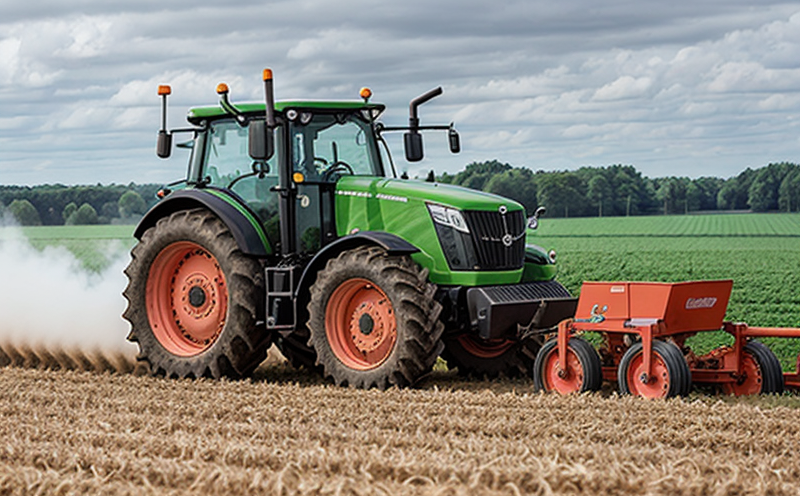Forage Harvester Cutting Quality Testing
The Forage Harvester Cutting Quality Testing service is designed to ensure that agricultural machinery meets strict quality and performance standards. This testing is critical for maintaining optimal crop yield, ensuring efficient operation of the harvester, and preventing issues that could arise from improper cutting techniques or faulty equipment.
Forage harvesting machines are crucial in the production of hay, silage, and other forages, which serve as essential feedstocks for livestock. The quality of the cut directly influences the nutritional value of the harvested material, affecting animal health and productivity. Therefore, testing cutting quality is paramount for ensuring not only compliance with agricultural standards but also for enhancing overall operational efficiency.
Our service involves a comprehensive set of tests to evaluate various aspects of the cutting process, including blade sharpness, cutter bar geometry, and the impact of different operating parameters on cut length, uniformity, and residue levels. By analyzing these factors, we can provide detailed insights into how each aspect affects overall harvesting performance.
One key component of our testing is ensuring that the forage is cut to an appropriate length. The ideal cutting height varies depending on the type of crop and the intended use of the harvested material. For instance, a longer cut may be preferable for haylage, while a shorter cut might be more suitable for baling hay. We use advanced measuring tools to ensure precise control over these parameters.
In addition to cutting length, we also assess residue levels. Excessive residue can lead to increased fuel consumption and reduced field efficiency. Our testing helps identify the optimal settings that minimize residue while maintaining a high-quality cut. This is particularly important for precision agriculture where every detail matters.
The quality of the cut also impacts the drying process and subsequent storage conditions, which are vital for preserving nutritional value and preventing spoilage. By optimizing these factors during the cutting stage, we help farmers achieve better results in post-harvest management.
| Aspect | Description |
|---|---|
| Blade Sharpness | Evaluation of blade edges to ensure they are free from wear and maintain optimal cutting performance. |
| Cutter Bar Geometry | Analysis of the cutter bar design and its impact on cut quality, including length, uniformity, and residue levels. |
| Operating Parameters | Assessment of various operating settings such as speed, height, and forward movement to achieve optimal cutting results. |
The testing process is conducted using state-of-the-art equipment that allows for precise measurements and detailed analysis. This includes laser measuring systems for cut length accuracy, high-resolution cameras for residue assessment, and sophisticated software for data interpretation. Our team of experts ensures that each test is thorough and reliable.
Why It Matters
The importance of forage harvester cutting quality testing cannot be overstated in the agricultural sector. Proper cutting not only enhances crop yield but also optimizes resource usage, reduces operational costs, and improves overall efficiency.
- Crop Yield Enhancement: Ensuring that each cut is optimal in terms of length and uniformity can significantly increase the amount of usable forage. This leads to higher production rates and better utilization of available land.
- Economic Efficiency: By minimizing waste and optimizing fuel consumption, farmers can realize substantial savings on both operational costs and resource use.
- Better Animal Health: The quality of the harvested forage directly affects animal health. High-quality feed ensures better nutritional intake, leading to healthier livestock and improved productivity.
In addition to these benefits, regular testing helps in identifying potential issues with the harvester before they become critical problems. Early detection allows for timely maintenance or replacement of components, preventing costly repairs and downtime.
Scope and Methodology
| Parameter | Acceptance Criteria |
|---|---|
| Cut Length Variability | ±5% variation from the set target length. |
| Residue Level | Average residue should not exceed 10% of the total cut volume. |
| Cut Uniformity | Uniformity index should be above 95% to ensure consistent cutting quality. |
The methodology for our testing is based on international standards, including ISO and ASTM guidelines. These standards provide a framework that ensures consistency and reliability in the testing process. By adhering to these protocols, we can offer accurate and repeatable test results.
International Acceptance and Recognition
- ISO/TC34 SC1 - Agricultural tractors and machinery
- ASTM D6507 - Standard Test Method for Determining Residue on Forage Crops
- EN 12893-2 - Agricultural machines - Self-propelled mowers, hay balers, hay conditioners, choppers and other similar equipment
- IEC 60472 - Machines for crop production - Forage harvesting machines
The acceptance of our testing results is widespread across the global agricultural community. Our compliance with international standards ensures that we meet the highest quality and performance expectations, making us a trusted partner for agricultural machinery manufacturers and farmers alike.





